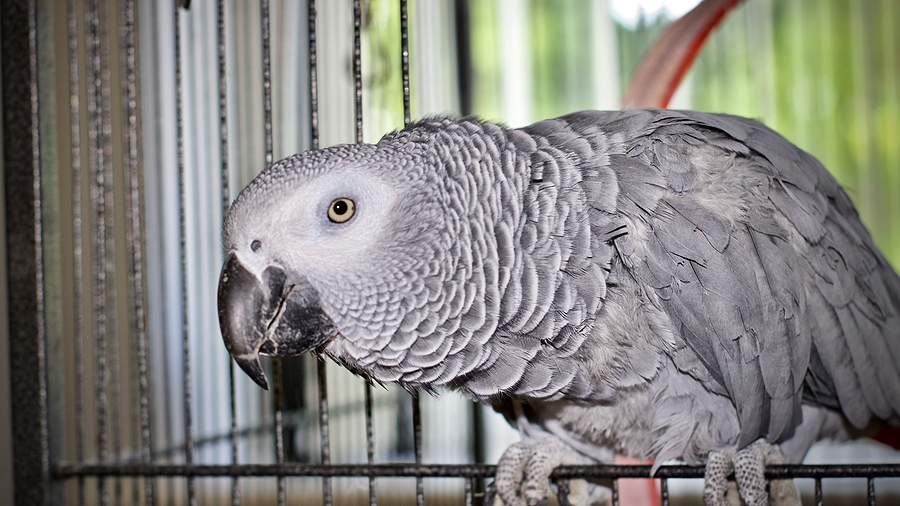Parrots can be a lot of fun. But sometimes they do things humans find annoying. This can include refusing to go back into their enclosures, biting, and vocalizing for attention. Parrots aren’t hatched with behavior problems. They learn through experience to do certain things to get desired outcomes. For example, if a scream causes people to come running into the room, a parrot can quickly learn to vocalize loudly to get attention from his favorite people.
Most parrot behavior problems can be prevented. But if your parrot is already doing something you don’t like, here are five tips to help you change his behavior.
- Always remember that parrots do things for a reason. Sometimes it is to get something they want, like your attention. Other times it is to avoid something they don’t want to do. For example, a parrot who doesn’t like to be touched may try to nip at a hand that is reaching out to touch his head. In this case the bird wants distance as a reinforcer. Try to figure out why your bird might be presenting behavior you don’t like. This will help you work on a solution.
- Sometimes changing things up can help get parrot behavior back on track. For example, if your parrot is famous for chewing on the wood trim of the house, an easy solution is to move his perch so he isn’t so close to the tempting trim. Or if your parrot likes to dump his food bowls, you can try using a different type of bowl that is easily secured to the cage. Solutions to some problems can be as simple as changing the environment so the unwanted behavior can’t happen.
- If your parrot has an option between doing two behaviors, the behavior that will be selected by the environment is the one that results in the best outcomes. For example, if your parrot climbs down his perch to roam around on the floor, it means the floor is much more reinforcing than the play stand. If your goal is for your bird to stay on the perch, it means you need to make the play stand a lot more exciting. This may involve adding new toys frequently and giving treats and attention when he is on the play stand. Any time your parrot is not doing what you want, ask yourself if you need to make it more reinforcing for him to do what you prefer.
- A great way to avoid biting problems and trust issues is to never force your parrot to do something he does not want to do. Always make sure your bird is a willing participant. Practice learning to recognize the body language a parrot shows when he is trying to say, “No thank you!” When you see this, stop what you are doing. Give yourself a moment to think about a way for there to be desired outcomes for your bird to do what you ask. It might mean getting some treats or taking a break and coming back later to interact with your parrot.
- The best way to have a well-behaved parrot is to train him to do what you want. Make a list of some things you would like your bird to do. It may include step up, go back into his cage, talk on cue, and more. Have training sessions to work on these behaviors so your parrot understands exactly what to do. Once he knows the behaviors, always offer treats, attention, toys, distance, or other things he likes whenever he does those behaviors when asked. This will help keep your parrot well behaved for the rest of this life. Remember, your parrot likes to have desired outcomes for his behavior just like you do.
Try using these Fear Free concepts with your parrot, and soon you will find behavior problems are a thing of the past.
This article was reviewed/edited by board-certified veterinary behaviorist Dr. Kenneth Martin and/or veterinary technician specialist in behavior Debbie Martin, LVT.
Barbara Heidenreich is an animal training consultant specializing in exotic animals. She consults worldwide working with zoos, universities, veterinary professionals, and conservation projects. She has worked onsite with over 80 facilities in 27 countries. She is an adjunct instructor at Texas A & M University. She has authored two books and contributed to four veterinary textbooks. She is a co-author of two Fear Free® Avian Certification Courses. Much of her work focuses on training exotic species to cooperate in medical care. Barbara is an advisor for the Animal Training Working Group and the Parrot Taxon Advisory Group for the European Association of Zoos and Aquariums. She has provided her expertise to conservation projects The Kakapo Recovery Program and The Borneo Orangutan Survival Foundation. Her goal is to leave behind a legacy of kindness to animals by sharing her expertise.
Want to stay in the loop on the latest and greatest in keeping your pet happy and healthy? Sign up for our free newsletter by clicking here!








